I grew up on Tampa Bay in the 1960s when the Sunfish and Sailfish were new. I fell in love with their simple look and low, sleek profile. So I badgered my Dad about building one without plans or the kit, in our back yard. He said, ‘No, no, no,’ and then my mother told him, ‘Yes.’ It was kind of an Ozzie and Harriet exchange:
You know, ‘Let’s go into the kitchen, have some milk and cookies and solve world problems, Dad.’
‘Okay son, what do you want to solve? World hunger? Steal the world’s supply of fruit cocktail? Bury your brother alive?’
‘No, Dad, none of that, just build a boat. How ‘bout it?’
‘Out of the question. How about your brother? Is he still alive, or have you sent him to the French Foreign Legion?’
‘It’s just a boat, Dad. All the guys have one but me. I’m depraved, and it’s your fault.’
‘I’ll get you a psychologist. The same one we take the cat to see.’
‘How ‘bout it, Dad? It’s just a fourteen footer. You can do it.’
Then my mother came out of the kitchen—her eminent domain—and said, ‘Why don’t you both build the boat, dear?’
That’s all it took. My Dad was a Lieutenant Colonel in the Air Force, the Strategic Air Command, so he knew when THE HIGHER COMMAND had spoken. We bought some ordinary plywood, steel nails, and built her. Unfortunately I had to go to college, so I never got to sail off to Tobago. But I never forgot that Sailfish with its lateen sail.
I’ve heard and read those skimmers could out sail Lightnings and Blue Jays, but why? They have precious little wetted surface to hold course, and they were always heavily built. Probably protecting the board from grounding and beaching was why the scantlings were strong, but why did they flit across Tampa Bay faster than a bad check?
Some time ago the sail writer for Small Craft Advisor made the same observation, coming to the conclusion the answer was the lateen sail. He writes under the name of Raven (I emailed him but he chose not to give his real name, so I can’t give him the credit he deserves). He really knows sails, so I’m sure he’s right. The sail was an equilateral triangle, with each spar the same length—I can’t remember if they were exactly the same length but it seemed so at the time. This shape seemed to draw the pressure of wind evenly to the three corners, as if the sail were controlling itself.
I think it’s the ideal sail for small boats. The mast required doesn’t have to be tall or have expensive hardware, it uses practically no rig, and it’s easily managed when the weather changes.
I rigged my first lateen in two ways.
| This is how I rigged the sail for stronger winds. |
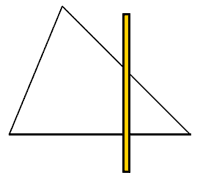 |
| This is how I rigged it for light winds.
It worked magnificently well. It has the
advantage of enabling you to see under
the sail as you tack. |
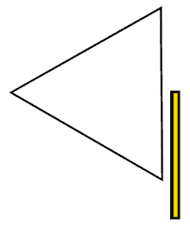 |
It was a tarp sail and crudely done, since I’d never made a sail before. I didn’t include any roach, due to an ignorance of the finer points of construction I inherited from my Dad. That old blue tarp sail proved to be so powerful I had to increase the depth of the rudder to keep from blowing into boats owned by people who could afford a lawyer.
Now if we could get into the Wayback Machine to 1899, we’d see Nathaniel Herreshoff designed the America’s Cup defender Columbia. This was a massive ship. For it he designed an 11 foot lifeboat lapstrake dingy, with an equilateral triangle. Barry Thomas of Mystic Seaport wrote a fascinating book on the dingy, with no mention of the sail except to give proportions. When I first saw it, the thing looked funny but now it looks simple. While the spars are longer than the dingy floor, the boom could serve as a tent prop quite easily.
The cover picture of the dingy show an effortless power through the water, as the Captain surely would never have a slow craft, even in a lifeboat.
Now when I look at photographs of Herreshoff one-mast designs, the sails look striking. I’ve wondered why that is, looking at them many times. They seemed to have one shape, one simple wind foil, one concept.
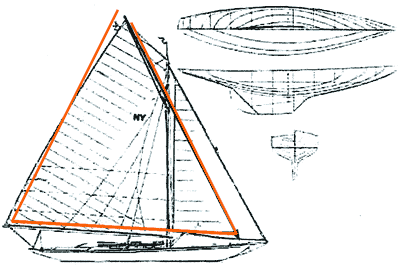
Where do they get this look? It may be from the triangular shape of equilateral sails divided by the mast, but not obscured. Here I’ve reproduced the lines of a New York 30, one of the fastest ships ever designed, with the triangular lines in red. Notice how parallel to the triangular leech the jib leech line is. If you look at photographs of the NY 30 and other cutters and sloops of the day, they all have this same appearance.
In other parts of the world, one huge lateen has been used, with spars for the boom and long gaff only. On a ship this large such a single sail would require a big crew and massively heavy tackle. Certainly for racing it couldn’t be done.
On the British Isles, ships have been tried with one long boom and two sails split at the mast. It never caught on, since it can’t be adjusted when the wind is not directly abeam. What Herreshoff has done is to retain the ability of this shape to be conducive to one direction of roach.
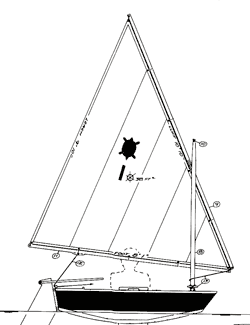 Now for a small boat like Mouse or Teal or the Laura Bay, this is a great sail. My favorite small craft is the Philip Bolger Tortoise, at 6 1/2 feet. At right, it uses a sail of 38 square feet. The dimensions of the sail are not exactly equilateral; the gaff is longer than the boom. This enables the sail to have some sail area above the mast for light winds without having much weight aloft. The boom, as you see, is slightly longer than the boat, giving the short waterline a balance. I think this is the ideal sail for any boat less than 11 feet long. But I give this warning. If you move the mast further aft to get the look of a jib before the mast, it doesn’t beat to windward any better. In fact at 38 square feet it de-powers it. If the sail were around 100 square feet on Teal or Laura Bay, the sail area before the mast would begin to have a jib effect. Now for a small boat like Mouse or Teal or the Laura Bay, this is a great sail. My favorite small craft is the Philip Bolger Tortoise, at 6 1/2 feet. At right, it uses a sail of 38 square feet. The dimensions of the sail are not exactly equilateral; the gaff is longer than the boom. This enables the sail to have some sail area above the mast for light winds without having much weight aloft. The boom, as you see, is slightly longer than the boat, giving the short waterline a balance. I think this is the ideal sail for any boat less than 11 feet long. But I give this warning. If you move the mast further aft to get the look of a jib before the mast, it doesn’t beat to windward any better. In fact at 38 square feet it de-powers it. If the sail were around 100 square feet on Teal or Laura Bay, the sail area before the mast would begin to have a jib effect.
If you’re worried about performance when the wind presses the sail against the mast, all it does is flatten the sail. This is an advantage when the weather changes quickly. It’s a kind of reef.
By the way, one advantage of a straight-sided boat is you can move the board forward or aft to assist sailing toward the wind or with the wind. If you put two leeboards on, moving one forward or aft can steer the boat without a rudder. This doesn’t work when the boat has flare, the stern just wiggles too much.
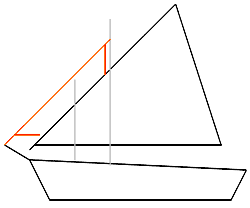 Now let’s try this. If you’re thinking of a boat in the 10 to 15 foot range you can use this method for designing the sail area. I’ve drawn a boat with the full length of the gaff the same length as the deck, extending at 45 degrees. The full length of the boom is the same as the gaff. You can make it longer or shorter, depending on how you want the boat to perform. Then you can draw the jib with its leech at 45 degrees also, just taller up on the mast as Herreshoff did with the New York. Just scale your drawing and you have a ballpark figure for the sail area. Of course, you’ll have to be aware of the weight of the boat and its submerged wetted surface, but this method works well on small sailing craft. Now let’s try this. If you’re thinking of a boat in the 10 to 15 foot range you can use this method for designing the sail area. I’ve drawn a boat with the full length of the gaff the same length as the deck, extending at 45 degrees. The full length of the boom is the same as the gaff. You can make it longer or shorter, depending on how you want the boat to perform. Then you can draw the jib with its leech at 45 degrees also, just taller up on the mast as Herreshoff did with the New York. Just scale your drawing and you have a ballpark figure for the sail area. Of course, you’ll have to be aware of the weight of the boat and its submerged wetted surface, but this method works well on small sailing craft.
I’ve found what appeals to my eye is what I like to sail. If I’m going to look up at a sail rig again and again when I’m sailing then I want something to keep me interested. I really like the look of rope across varnished wood. Now let’s look at a much bigger boat, using our triangle to design huge sails.
The great American Ship is the schooner. It’s probably the most versatile rig ever to be created, since the on deck length can be divided so many ways. All kinds of sails are possible — gaffs, spankers, triangular topsails, square topsails, fisherman’s staysail, triangular staysails, and different length gaffs.
Now if you’d like a schooner with traditional, classic looks which makes your schooner turn heads even when girls are near boys, this is what you do.
First, decide on the length on deck. Then divide it into three parts with two masts. Make the outside sections a bit longer than the inside one. I don’t use a numbers formula, just do it till it looks good.
Then draw your foremast and mainmast the same height. You can add to the mainmast later. The two masts should be around 2/3 the length of the deck. Now draw a bowsprit 1/3 the length of the foremast.
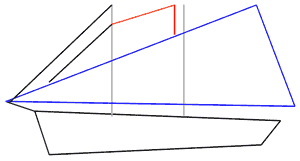 Now we begin with the sail as a triangle. The line of the booms goes from the bow sprit to the stern. The other long line of the triangle goes from the same bowsprit point to the same height as the mainmast. Now connect the ends of the lines. I’ve drawn the triangular lines in blue. Now we begin with the sail as a triangle. The line of the booms goes from the bow sprit to the stern. The other long line of the triangle goes from the same bowsprit point to the same height as the mainmast. Now connect the ends of the lines. I’ve drawn the triangular lines in blue.
Now draw the foremast gaff with the same gaff to mast angle as the mainmast. I’ve put this line in red.
Then draw the headsails to the top of the foremast. Two sails is the ultimate in head-turning. I’ve put two of them in black.
These dimensions can be changed, they are the guide to schooner sails. These proportions are pretty close to the sail plan George Steers drew for America, based on the lines the British took off of her after she won the 100 Guineas Cup, forever known thereafter as the America’s Cup.
*****
|

